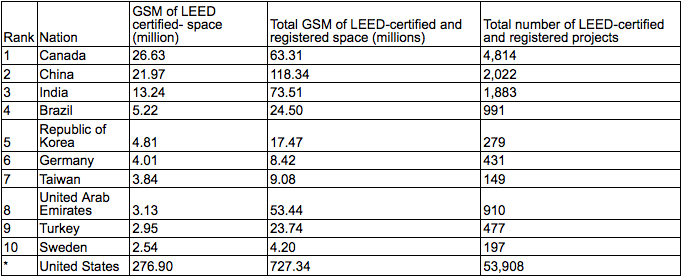For the second year in a row, Canada takes top spot in the United States Green Building Council’s (USGBC) annual LEED green building ranking list.
The USGBC rates countries in terms of gross square metres and number of LEED projects to date. In order for a project to be LEED-certified, it must meet strict limitations on energy and water usage and carbon emissions.
“At a time when the world needs real leadership to solve the problems facing us all, Canadian business leaders, policymakers and consumers have turned to LEED to show the international community what we can do at the local level to promote real, substantive change,” said USGBC CEO and founding chair Rick Fedrizzi.
“It is always encouraging to see highly developed nations such as Canada rally around the idea that increased sustainability does not need to come at the expense of a high standard of living, and that making this type of commitment actually enhances national well being.”
Noteworthy LEED projects in Canada include the Exchange Tower in Vancouver, the Bell Trinity Square project in Toronto, the Atlantic Avenue Art Block in Calgary and the Nirlon Knowledge Park, Building 6, in Edmonton.
LEED was developed in the United States, and that country was not included the list "but remains the world's largest market for LEED," the USGBC said. The council also said with the world’s largest GDP, the U.S. is the world’s second-largest greenhouse-gas producer.
(Source: USGBC)
Buildings are the fourth-highest contributor of greenhouse gas emissions in Canada, according to the federal government, accounting for 12% of total emissions. The USGBC said although Canada’s population has grown since 2005, emissions from Canadian buildings have fallen over this period.
“Given Canada's climate and its intense heating needs during its harsh winter, this decrease in energy usage demonstrates a strong commitment to transforming the national built environment in ways that promote a healthier, more sustainable future,” the USGBC said in a release.




